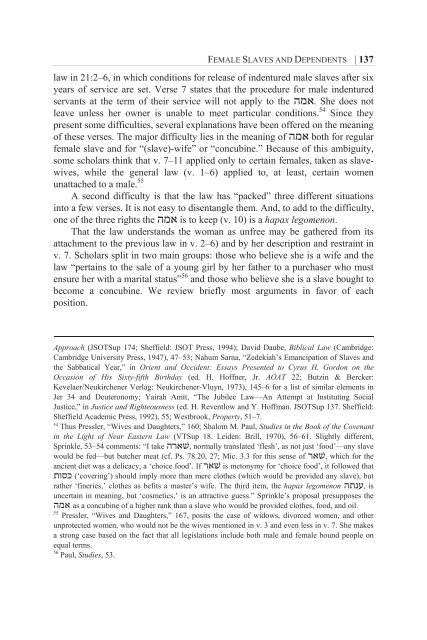Women at Work in the Deuteronomistic History - International Voices ...
Women at Work in the Deuteronomistic History - International Voices ...
Women at Work in the Deuteronomistic History - International Voices ...
You also want an ePaper? Increase the reach of your titles
YUMPU automatically turns print PDFs into web optimized ePapers that Google loves.
FEMALE SLAVES AND DEPENDENTS | 137<br />
law <strong>in</strong> 21:2–6, <strong>in</strong> which conditions for release of <strong>in</strong>dentured male slaves after six<br />
years of service are set. Verse 7 st<strong>at</strong>es th<strong>at</strong> <strong>the</strong> procedure for male <strong>in</strong>dentured<br />
servants <strong>at</strong> <strong>the</strong> term of <strong>the</strong>ir service will not apply to <strong>the</strong> המא. She does not<br />
leave unless her owner is unable to meet particular conditions. 54 S<strong>in</strong>ce <strong>the</strong>y<br />
present some difficulties, several explan<strong>at</strong>ions have been offered on <strong>the</strong> mean<strong>in</strong>g<br />
of <strong>the</strong>se verses. The major difficulty lies <strong>in</strong> <strong>the</strong> mean<strong>in</strong>g of המא both for regular<br />
female slave and for “(slave)-wife” or “concub<strong>in</strong>e.” Because of this ambiguity,<br />
some scholars th<strong>in</strong>k th<strong>at</strong> v. 7–11 applied only to certa<strong>in</strong> females, taken as slavewives,<br />
while <strong>the</strong> general law (v. 1–6) applied to, <strong>at</strong> least, certa<strong>in</strong> women<br />
un<strong>at</strong>tached to a male. 55<br />
A second difficulty is th<strong>at</strong> <strong>the</strong> law has “packed” three different situ<strong>at</strong>ions<br />
<strong>in</strong>to a few verses. It is not easy to disentangle <strong>the</strong>m. And, to add to <strong>the</strong> difficulty,<br />
one of <strong>the</strong> three rights <strong>the</strong> המא is to keep (v. 10) is a hapax legomenon.<br />
Th<strong>at</strong> <strong>the</strong> law understands <strong>the</strong> woman as unfree may be g<strong>at</strong>hered from its<br />
<strong>at</strong>tachment to <strong>the</strong> previous law <strong>in</strong> v. 2–6) and by her description and restra<strong>in</strong>t <strong>in</strong><br />
v. 7. Scholars split <strong>in</strong> two ma<strong>in</strong> groups: those who believe she is a wife and <strong>the</strong><br />
law “perta<strong>in</strong>s to <strong>the</strong> sale of a young girl by her f<strong>at</strong>her to a purchaser who must<br />
ensure her with a marital st<strong>at</strong>us” 56 and those who believe she is a slave bought to<br />
become a concub<strong>in</strong>e. We review briefly most arguments <strong>in</strong> favor of each<br />
position.<br />
Approach (JSOTSup 174; Sheffield: JSOT Press, 1994); David Daube, Biblical Law (Cambridge:<br />
Cambridge University Press, 1947), 47–53; Nahum Sarna, “Zedekiah’s Emancip<strong>at</strong>ion of Slaves and<br />
<strong>the</strong> Sabb<strong>at</strong>ical Year,” <strong>in</strong> Orient and Occident: Essays Presented to Cyrus H. Gordon on <strong>the</strong><br />
Occasion of His Sixty-fifth Birthday (ed. H. Hoffner, Jr. AOAT 22; Butz<strong>in</strong> & Bercker:<br />
Kevelaer/Neukirchener Verlag: Neukirchener-Vluyn, 1973), 145–6 for a list of similar elements <strong>in</strong><br />
Jer 34 and Deuteronomy; Yairah Amit, “The Jubilee Law—An Attempt <strong>at</strong> Institut<strong>in</strong>g Social<br />
Justice,” <strong>in</strong> Justice and Righteousness (ed. H. Reventlow and Y. Hoffman. JSOTSup 137. Sheffield:<br />
Sheffield Academic Press, 1992), 55; Westbrook, Property, 51–7.<br />
54 Thus Pressler, “Wives and Daughters,” 160; Shalom M. Paul, Studies <strong>in</strong> <strong>the</strong> Book of <strong>the</strong> Covenant<br />
<strong>in</strong> <strong>the</strong> Light of Near Eastern Law (VTSup 18. Leiden: Brill, 1970), 56–61. Slightly different,<br />
Spr<strong>in</strong>kle, 53–54 comments: “I take הראשׁ, normally transl<strong>at</strong>ed ‘flesh’, as not just ‘food’—any slave<br />
would be fed—but butcher me<strong>at</strong> (cf. Ps. 78.20, 27; Mic. 3.3 for this sense of ראשׁ, which for <strong>the</strong><br />
ancient diet was a delicacy, a ‘choice food’. If ראשׁ is metonymy for ‘choice food’, it followed th<strong>at</strong><br />
תוסכ (‘cover<strong>in</strong>g’) should imply more than mere clo<strong>the</strong>s (which would be provided any slave), but<br />
r<strong>at</strong>her ‘f<strong>in</strong>eries,’ clo<strong>the</strong>s as befits a master’s wife. The third item, <strong>the</strong> hapax legomenon התנע, is<br />
uncerta<strong>in</strong> <strong>in</strong> mean<strong>in</strong>g, but ‘cosmetics,’ is an <strong>at</strong>tractive guess.” Spr<strong>in</strong>kle’s proposal presupposes <strong>the</strong><br />
המא as a concub<strong>in</strong>e of a higher rank than a slave who would be provided clo<strong>the</strong>s, food, and oil.<br />
55 Pressler, “Wives and Daughters,” 167, posits <strong>the</strong> case of widows, divorced women, and o<strong>the</strong>r<br />
unprotected women, who would not be <strong>the</strong> wives mentioned <strong>in</strong> v. 3 and even less <strong>in</strong> v. 7. She makes<br />
a strong case based on <strong>the</strong> fact th<strong>at</strong> all legisl<strong>at</strong>ions <strong>in</strong>clude both male and female bound people on<br />
equal terms.<br />
56 Paul, Studies, 53.




